Selecting and placing plants in the landscape is the art and science of arranging plant material to make a healthy, functional, and beautiful yard. The mix of science and art is expressed in the guiding principle of "right plant, right place," meaning to select plants that can thrive in the growing conditions of the site and locating them for both visual appeal and health. Selecting and arranging plants are the last steps in the overall design process after the site analysis is complete and the activity areas located and designed.Developing the planting plan is a sequential process, but it is important to remember that the process is not completely linear; sometimes decisions about plant material require reworking previous steps in the sequence and making adjustments to the plan. The process begins with developing a functional plan that shows the general concept for the landscape.
Step 1: Concept/functional plan
Developing a conceptual plan that shows the proposed general layout of the plant material is the first step in the process. The conceptual plan is based on the site analysis and the needs of the person or family using the space. This ensures that the plan is based on the site conditions and the desired function of the plants. See Landscape Design: Analyzing Site Conditions (https://edis.ifas.ufl.edu/ep426) for more information on site inventory and analysis. Figure 1 is a conceptual plan that shows the location of plant material with functional notes to create shade and privacy, control views, hide unsightly utilities, and draw attention to the front entry as a focal point. The labels that describe the function of the planted areas guide the selection of plants to best serve the function, such as wide canopy trees for shade and interesting and colorful plants for the focal point.
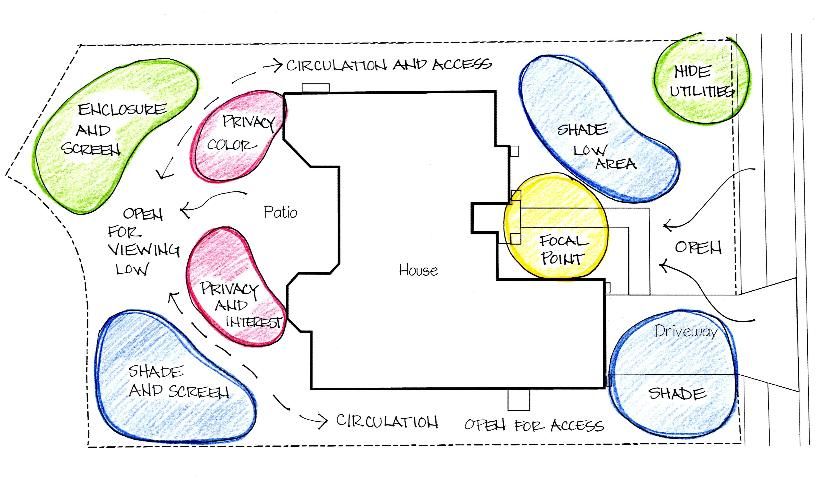
Credit: Gail Hansen
Step 2: Master plant list
Creating a master list of possible plant materials for use in the planting plan is the second step in the process. The first consideration is to choose the right plants for the site conditions. Refer to the site analysis to determine the growing conditions in each area of the yard and match plant choices to those conditions. Remember to consider light requirements (sun or shade) for each plant as well as soil and water requirements. Also consider the USDA Hardiness Zone and the temperature ranges for the area. See Right Plant, Right Place: The Art and Science of Landscape Design – Plant Selection and Siting (https://edis.ifas.ufl.edu/ep416) to learn more about the science of selecting plants for growing conditions. Once growing requirements are satisfied, consider the visual characteristics of each plant as you create the list.
Don't forget the existing plants in the landscape. Depending on the health of the existing plants and the new layout for activity spaces, some of the existing plants may need to be removed or relocated. Any healthy existing vegetation that can be used with the new plan should be considered for saving, and all old, unhealthy, or overgrown plants and invasive exotics should be removed. Consider relocating plants that may not be at their best but would benefit from a better location.
Mature trees are the most important existing vegetation. Decide which trees you would like to keep and try to work the planting plan around them. Mature, healthy trees add value to your property and beauty and function to your yard. Trees with large shade canopies help cool the home and reduce the need for air conditioning. Trees also influence the type of plants and turfgrass appropriate for shady conditions. If you are unsure about keeping trees, consult an arborist to determine the health and projected longevity of the tree. If trees could present a problem in the future because of location or size, it is best to remove them while they are small.
Start the master plant list with familiar plants that you know thrive in the area. Observe landscapes in your neighborhood or community and learn about the plants you would like to use in your yard. When selecting plants, make sure they are locally available. Consult several sources for information on the growth habits and requirements of the plants. Additional information about plant selection is available from your local county Extension office (www.solutionsforyourlife.com/map) or on the Florida-Friendly website, http://fyn.ifas.ufl.edu/publications.htm, where you can download The Florida-Friendly Landscaping™ Guide to Plant Selection & Landscape Design for a complete list of Florida-Friendly plants. Make sure to choose plants appropriate for the USDA Hardiness Zone, soil pH, and moisture and light conditions noted on the site inventory and analysis. Basic information on the plant list should include the general size, plant texture, shape, color of flowers and/or foliage, and required light conditions. Additional information can include the mature height and spread, seasonal changes, and the bloom period. This information is useful when arranging plants for aesthetic appeal. See Landscape Design: Aesthetic Characteristics of Plants (https://edis.ifas.ufl.edu/ep433) for guidelines on selecting plants for visual appeal. Group the plants on your list based on type and function, such as trees (structural or focal), shrubs (structural), and groundcover (massing). List a reasonable number of proposed plants in different sizes. The goal is to have a good selection without being overwhelmed by the variety of choices (Table 1). Table 1 is an example of a partial plant list with plant characteristics for easy reference when selecting final plant choices.
Step 3: Preliminary planting plan
Preliminary plans show the proposed layout of the individual plant material. The quick sketches are used to explore different layouts and arrangements to get a rough idea of the size constraints and best locations for plants. Several preliminary plans are often used to create one final plan, taking the best ideas from each plan. Use simple circles and free-form lines to indicate plant material location and size. Color palettes can also be tested by using colored pencils to draw the plants (Figure 2).
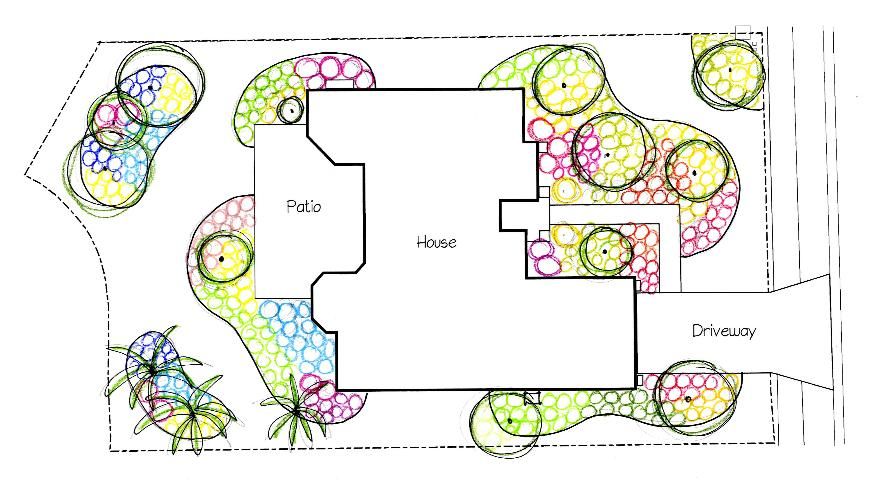
Credit: Gail Hansen
Step 4: Locate and draw plant beds
Use the preliminary plan to start developing plant beds on the base map where plant material will be located, typically around buildings, on the edges of sidewalks and driveways, along fence and property boundaries, and around features in the landscape, such as pools and patios. Plant beds are traditionally curvilinear and follow the form of the building, driveway, or walkways. The meandering bedline typically undulates to create deep and shallow beds for a natural look (Figure 3). General rules for drawing bedlines for plant beds include the following:
- Use the arc and tangent to generate the form of the plant bed edges.
- Create dramatic, sweeping curves when drawing on the paper. Shallow curves on paper tend to look like straight lines when standing in the yard and viewing the plant bed. Shallow beds are typically used on the side of the building where property lines constrain the depth of the bed.
- Use the shape of the building and the hard surfaces to guide the location of the bedline. Draw a wide arc on the corners of buildings, walkways, and patios to provide enough room for larger plants.
- Note that plant bed depth typically ranges from 5 feet for a shallow bed to 30 feet for deep beds.
- Use very wide, deep curves (1/2 or 3/4 circle) on outside and inside corners.
- Note that plant beds that originate at a building or hardscape edge should begin perpendicular to the straight edge before beginning the curve.
- Locate plant beds under trees just inside the drip line (the outside edge of the tree canopy) of the tree for aesthetic and protection purposes.
- Use floating plant beds (beds not connected to a building or walkway) to create spaces and locate structural plants, such as large trees, in the yard.
- Create "spaces" by using bedlines to define the edge of open sod or mulch areas. These open areas or voids in the landscape are used for recreation and entertaining or as a simple open foreground area that highlights the more complex plants in the background.
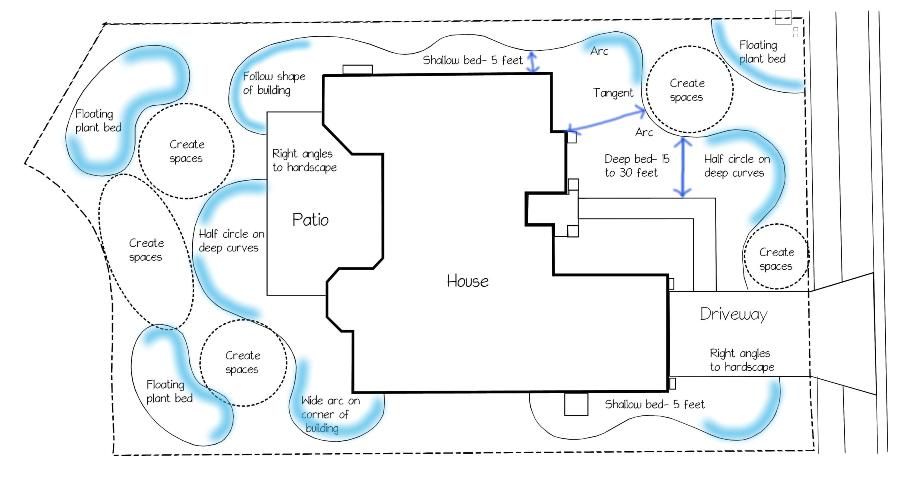
Credit: Gail Hansen
Once the plant beds have been defined, they need to be filled with plants. There is a logical order to placing the plants, depending on the type of plant and the role it plays in the landscape. Large plants, such as trees, which separate spaces by creating implied walls, are called structural plants because they provide structure in the yard. They are also long lived and permanent through the seasons, so they add stability to the garden. These are the first plants to be located on the plan. Focal or anchor plants are located next. These are plants that are strategically located to create emphasis, attract attention, or provide an anchor in the various plant beds. The last plants to be placed are the massing plants, which fill in the plant beds and make up the majority of the plants in the beds. For more information about arranging plants, see Landscape Design: Arranging Plants in the Landscape (https://edis.ifas.ufl.edu/ep449).
Step 5: Locate structural plants
Structural plants are large trees and shrubs. The trunks of the trees act as implied walls to separate the activity areas of the yard or to create a screen along the property line (Figure 4). Trees also provide enclosure overhead with branches and canopies to give a space human scale. There are several guidelines to follow when locating trees:
- Make sure the size of the mature trees and shrubs is proportional to the building and the overall size of the site. Tall buildings and large sites need tall and large trees for balance.
- Give the trees and shrubs room to grow. Don't locate them too close to buildings and sidewalks or patios.
- Locate trees to provide shade over the air conditioner and help conserve energy by blocking sun on the east and west sides of the building.
- Avoid locating structural plants where falling leaves, fruit, or twigs will create a problem.
- Use trees to block unsightly views or frame an attractive view.
- Consider how the color, texture, and form will look with the building colors and materials.
- Use the large mass of the tree canopy to balance the mass of the building.
- Locate plants to avoid power lines and underground utilities, such as water lines and septic systems.
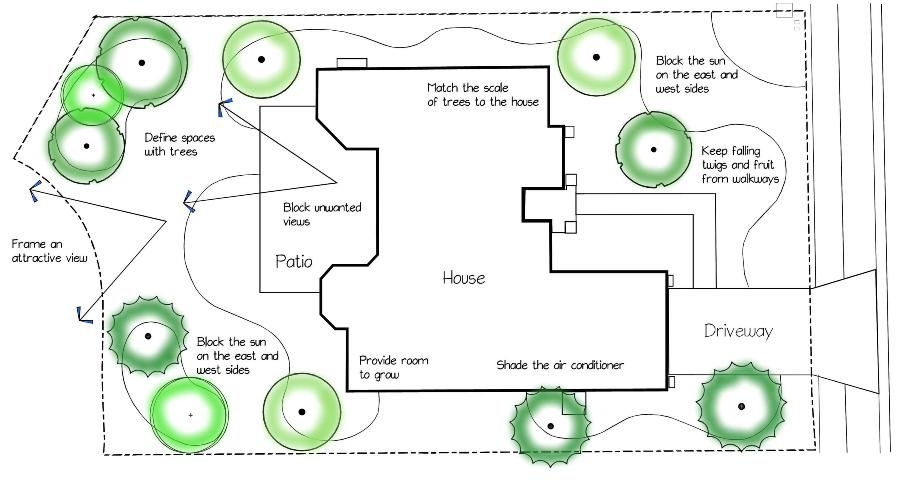
Credit: Gail Hansen
Step 6: Locate focal and anchor plants
Focal/anchor plants can be medium to large shrubs and small trees. They are considered both focal and anchor plants because they can serve as a focal point and an anchor for plant beds. Anchor plants are sometimes called "theme plants" because they most often establish the design theme for the yard. Focal plants are characterized by an unusual shape, color, or texture that contrasts with other plants. Focal plants attract attention to a particular area of the yard or, through careful location, lead the eye around the yard (Figure 5). Anchor plants provide unity through repetition in the plant beds. There are several considerations when locating focal/anchor plants:
- Choose plants that have high contrast with surrounding plants.
- Locate plants in view of natural sight lines, such as the end of a walkway or the view from a window or door, a patio, or the sidewalk and street.
- Place a focal point opposite an unattractive area to divert attention from the poor view.
- Limit the use of focal points. Too many can cause confusion about where to focus attention and make the eye jump around the space.
- Use other elements with the plants for the greatest contrast. Brightly colored ceramic pots are a good choice.
- Use structures and features such as trellises, sculptures, and birdhouses among plants as focal points.
- Create a focal point with a nice composition of colorful plants. Grouping colorful plants at the front door is a good example.
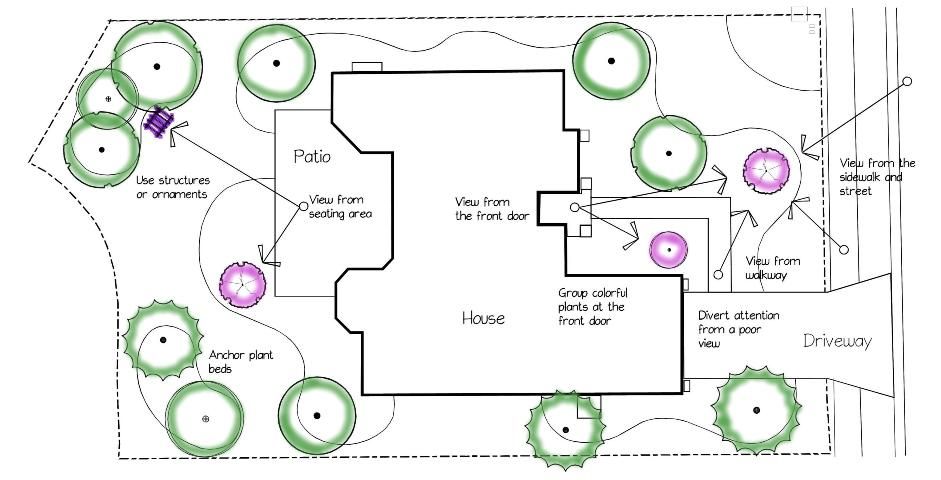
Credit: Gail Hansen
Step 7: Locate massing plants
Massing plants are the medium and small shrubs and groundcover that fill out the plant beds. These plants make up most of the plant material in the beds and should have a variety of textures, colors, and shapes for interest. One approach to locating massing plants is to draw free-form or irregular "bubbles" within the plant beds to show the location and extent of a particular plant cluster (Figure 6). Guidelines for using bubbles to represent plant location include the following:
- Use horizontal and vertical layering. Vertical layering is the use of a variety of heights for interest, and horizontal layering is the use of plant masses within beds.
- Draw bubbles to indicate the horizontal layers along the ground plane so they touch each other and overlap in offset, interconnected layers.
- Keep in mind that the greater the depth of the plant bed, the greater the number of horizontal layers. A shallow bed may only have one or two layers, while a deep bed may have six or seven layers.
- Draw the shape of the bubble as the desired shape of the mass because each bubble represents a different mass or cluster of the same plant.
- Draw the first bubble on the plan next to a building, fence, or hardscape edge because this is a fixed edge that does not allow flexibility in the bubble shape.
- Work the bubbles out into the landscape toward the plant bed edge where there is more flexibility. Both the edge of the bed and the bubbles can be reconfigured throughout the process until a good fit and form are created.
- Typically, it is better to mold the shape of the bubbles to fit in the plant beds.
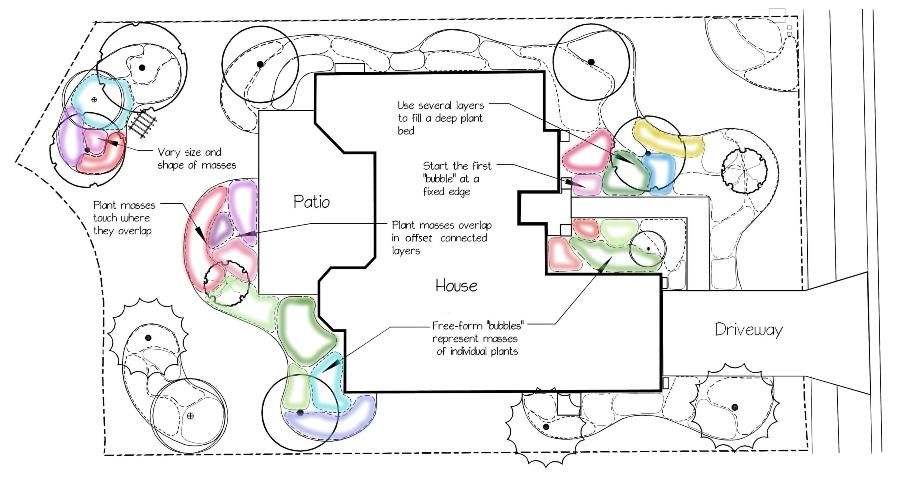
Credit: Gail Hansen
Step 8: Specify plant characteristics
The next step is to specify the aesthetic characteristics of the plant that will be placed in each bubble. Label each with the flower or foliage color, the desired texture, the form, the height and size, the type of plant (e.g., shrub, annual, or perennial), and the seasonal characteristics, such as evergreen or deciduous. See Landscape Design: Aesthetic Characteristics of Plants (https://edis.ifas.ufl.edu/ep433) for more information about using plant characteristics to develop plant compositions. Below are some general guidelines to follow as you select plants based on characteristics:
- Start with the structural plants and focal plants. These plants have a high functional value, so consider the function first (e.g., shade or a focal point) and think about the height, shape, and seasonal variation that affect the function.
- Develop a smooth transition across the top of the plants from the tallest plants to the lowest plants and back, both from front to back and side to side.
- Balance the distribution of deciduous and evergreen plants, as well as perennial and annual plants, so there are no large gaps when plants go bare or go down in the winter.
- Give structural plantings (trees and shrubs) the highest percentage of evergreen plants to maintain the structure and organization of the garden.
- Place larger plants with less detail farther away from the viewer (to the back of the plant bed), and place plants that have finer detail and more interest for close-up viewing in the front of the bed or closest to the viewer.
- Remember the activities that take place adjacent to the plant beds (i.e., use plants with a neat growth habit next to walkways [avoid sprawling plants], and choose soft plants with no thorns near play areas).
- Keep in mind the color scheme, and balance the distribution of color by location and through the seasons. Remember, color is temporary and should only be used to enhance the planting. The composition should be pleasing without color.
- Create interest by including a variety of heights, shapes, and textures. Achieve unity through the careful location of each.
After the structural and focal plants have been described, specify the plants in the bubbles closest to the house, using the color and texture of the building as your starting point. For example, if the wall façade is a light-colored rough stone, the plants next to the wall could contrast by using dark green, smooth foliage, or blend by using light green, rough-textured foliage. Once you have described the first bubble, move to the adjacent bubble and label it. As you progress from bubble to bubble, keep in mind the characteristics of the surrounding plants. Work back and forth between bubbles until you have the right combination of characteristics and all bubbles are labeled (Figure 7). Remember, a number of plants on the list will fit the characteristics, so there is flexibility throughout the process.

Credit: Gail Hansen
Step 9: Select plants and draw on the plan
Each plant mass is assigned a plant from the master plant list based on aesthetic characteristics and growing requirements. Review the list and select the plant that matches the most possible aesthetic characteristics listed for each bubble. Also, match the growing requirements for each plant to the site condition for each bubble. For most growing conditions, there is typically a wide choice of plants, so the final decision is usually based on aesthetic characteristics. Remember, however, to always consider the growing conditions first. An aesthetically pleasing plant is of no use if it will not survive and thrive in the desired location. In more restrictive growing conditions, such as deep shade or very moist soil, the growing requirements may limit plant choices. Review the visual characteristics of the final plant choices to ensure a good variety of textures and forms for interest and a mix of colors that supports the color scheme. Once you have determined the plant for each bubble, the individual plants must be drawn to show the exact location and size of each plant. The landscape installer or homeowner will use the plan to locate the plant in the field and to purchase the correct number of plants. The technical process for drawing the plants is as follows:
- Draw each plant as an individual circle with a diameter the same size as the width of the mature plant. A plant with a 2-foot spread at its mature size is represented with a circle drawn at a 2-foot diameter at the scale of the plan, which is typically 10 scale (1 inch equals 10 feet, 0 inches).
- Represent the spacing of the plants (circles) on the plant schedule by noting the distance between the centers of the circles (i.e., the center of the plants) as measured from center to center of the plant. For example, a plant spacing of 2' o.c. (2 feet on center) means that plants with a 2-foot mature spread are planted 2 feet apart from center to center, so they touch when at their mature size.
- Fill the bubble with plants by staggering the circles in a rickrack pattern to fit the plants as closely as possible (Figure 8).
- Draw the first plant next to the building or a hard edge and work along the edge or edges, then out into the bubble until it is filled.
- Distinguish circles of the same size that represent different plants by using different symbols (see graphic plan, Figure 9) or a different color to be graphically clear.
- Continue filling the bubbles with the plant symbols until all the plants have been organized.
- Make adjustments to the outside edge of the plant bed or in the number of plants in the bed as necessary to maintain the form of the plant bed.

Credit: Gail Hansen
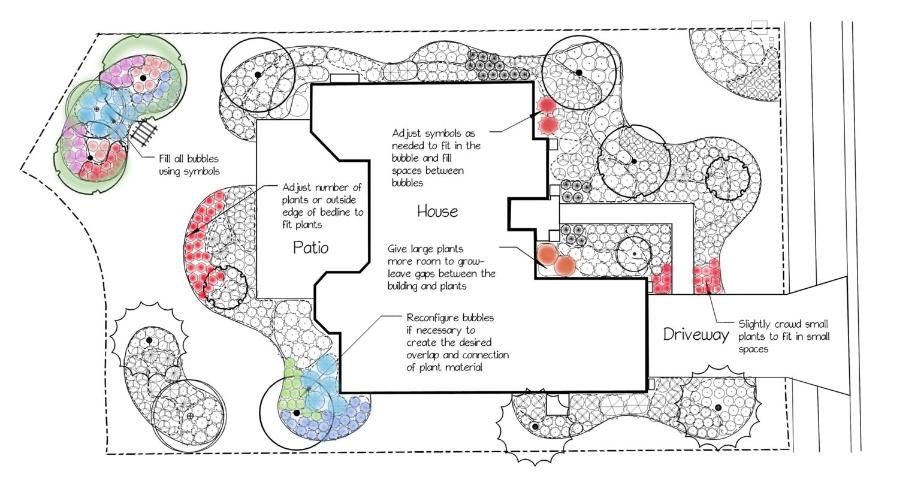
Credit: Gail Hansen
Step 10: Labels and plant schedule
Each symbol represents a different plant that must be identified by a count and the name of the plant. The count represents the number of plants that are in the cluster or mass (Figure 10). After all the plants have been identified and counted, the total number of each type of plant is determined by adding the count of the separate plant masses together. Leader lines are drawn from one of the plant symbols in the mass to a blank space on the plan where the count and name can be written. Draw the leader lines as short as possible and don't cross lines to avoid confusion. Labels can be drawn in the footprint of the house or any open area on the plan and outside of the property boundaries of the plan. For clarity, it is best to keep all of the text at the same angle and group the labels so they are easier to find on the plan.
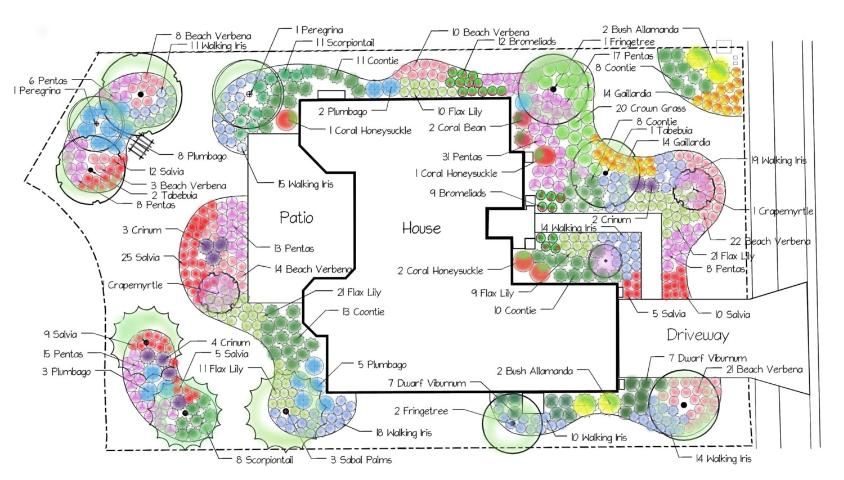
Credit: Gail Hansen
The final plant schedule is a list of all the plants on the plan with the total quantity for each plant. Each plant is listed by the common name and the scientific name. Common names can vary, and some plants have more than one common name, so the scientific name is required to ensure that the correct plant is purchased by the homeowner or installer. The size of the container for each plant and the spacing for installation is indicated. The spacing shows the distance from center to center of each plant at the time of installation. Table 2 shows a typical plant schedule for pricing and installation.
Key concepts to remember
The key concept to remember when drawing a planting plan is to select the right plant and locate it in the right place. Selecting plants requires consideration of the growing requirements that match the site conditions, the aesthetic characteristics of the plant (color, texture, form, and size), the functional role of the plant, and the maintenance requirements of the plant. This concept is referred to as the art and science of planting design.
Additional Resources
Austin, R. 2002. Elements of Planting Design. New York: John Wiley & Sons.
Bertauski, T. 2005. Designing the Landscape: An Introductory Guide for the Landscape Designer. Upper Saddle River, NJ: Pearson Prentice Hall.
Booth, N. 1990. Basic Elements of Landscape Architectural Design. Prospect Heights, IL: Waveland Press.
Scarfone, S. 2007. Professional Planting Design: An Architectural and Horticultural Approach for Creating Mixed Bed Plantings. New York: John Wiley & Sons.
Thomas, H., and S. Wooster. 2008. The Complete Planting Design Course: Plans and Styles for Every Garden. London: Octopus Publishing Group.
Walker, T. 1991. Planting Design. New York: Van Nostrand Reinhold.